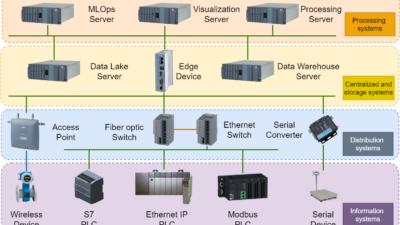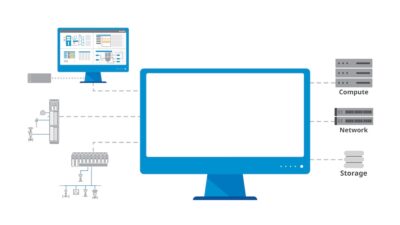Collect usable data as the first step toward effective analysis.

The Industrial Internet of Things (IIoT) offers manufacturing organizations almost unimaginable potential to change the way managers and operators do their jobs by connecting production equipment to the cloud. In fact, Accenture, the global management consulting and professional services firm, has forecast that IIoT could add as much as $14.2 trillion to the global economy by 2030 by increasing productivity and detecting production problems early, while they can be corrected efficiently and economically.
For many, figuring out how to install the sensors and interconnections necessary to link all their hardware to a central database can seem like an overwhelming and expensive prospect. Large manufacturers typically have the ability to invest in implementing facility-wide or enterprise level IIoT platforms. Small to medium-sized organizations, however, often feel hamstrung by far smaller IT budgets and staffs, as well as by management’s unwillingness to accept the temporary disruptions to production a facility-wide conversion to IIoT might cause.
First things first
For manufacturing organizations like these, consider the “baby steps approach,” sometimes also called a discrete implementation. Essentially, this means that, early on, it’s important to stop worrying so much about uploading lots of data to the cloud and doing trending analysis, but focus instead on collecting usable data from equipment where it wasn’t being collected before. Think about taking on one small project at a time and mastering it before moving on to the next challenge.
This approach to IIoT focuses on making progress incrementally in a way that doesn’t come with the same financial, personnel or workflow interruption consequences that larger systems would. It offers a more realistic and economical starting point for many smaller manufacturing organizations. Starting with one specific application, rather than trying to apply IIoT to the whole facility, makes implementing IIoT far more manageable and affordable. What’s more, it forces managers to focus on a specific problem, ensuring a quick payback on the effort. By providing a fast return on a modest investment, it also inspires confidence that future steps will provide equally positive results.
Compressed air is an expensive resource in any manufacturing facility, so monitoring the performance of the compressed air system is a good first step in a discrete implementation of IIoT. Keeping these systems operating at peak efficiency offers big payback because losses due to leakage waste lots of energy. Inline sensors can be installed to monitor compressed air system variables such as pressure, flow, humidity, temperature and power consumption. Once collected, this data can be sent to a platform for conversion into a form that’s useful to the maintenance team. This data collection point can be the start for a facility-wide system for monitoring leakage and other system losses.
Five ways to think small about IIoT
Keeping these five tactics in mind can simplify the early stages of IIoT implementation for small to medium-sized companies:
1. Make your first bite a nibble, not a gulp. In just about every organization, the larger the budget for a project, the more people who must approve it and the more intense the payback monitoring will be. However, it can be tough to show a return on investment (ROI) quickly with an IIoT implementation because the implementation team is learning as they go. Rather than asking for all the money up front, it’s easier to ask for a few hundred dollars to cover the cost of some smart sensors, demonstrate the value of the information they deliver, and build management confidence in the concept.
2. Focus on the biggest trouble spots. Take the time to review maintenance records to determine which machines or processes in your facility represent the most significant sources of maintenance problems. These are the points where you should begin collecting data. Equipment with hard-to-find parts or difficult or expensive to repair also should be at the top of your list, as well as any machines that could represent a danger to personnel or other pieces of equipment if they fail because a problem went undetected.
3. Determine what you need to monitor to improve that asset’s operating efficiency. Component parameters such as temperature, pressure, humidity and vibration provide important clues that can indicate an asset’s condition and spot trouble before it happens. Collect the pertinent data and take a methodical approach to using this information. Assume that you’ve installed some smart sensors to monitor the voltage level of one of the components of a specific piece of equipment; an elevated voltage over an extended period might be an indication of future problems.
The next step is to decide how frequently this data should be reported back to the controller. Too long of an interval runs the risk of missing a fast-emerging problem, making it impossible to react in a timely way. Too short an interval can generate a flood of data that’s never analyzed and never used.
4. Choose a robust internet infrastructure. The solution chosen should include a centralized collection server capable of receiving and transmitting data from all the sensors and other devices that could eventually be integrated into the network.
One method of data transmission is through the programmable logic controller (PLC), which is easy to implement. Choosing the right protocol to connect sensors with controllers and actuators is critical to the success of any IIoT implementation. IO-Link is a cost-effective open communications protocol that supports simple, scalable, point-to-point communications between sensors or actuators and the controller. It also allows two-way communications to receive data and then download a parameter to the device/actuator.
As a result, processes can be adjusted remotely. The advantages of IO-Link include the automatic detection and parameterization of the IO-Link device, device monitoring, diagnostics, changes on the fly and reduced spare part costs. Ultimately, the key to unlocking the power of smart sensors is in making diagnostic information easy to access. IO-Link allows for cyclic data exchange capabilities so that programmers easily can send the information directly to where it is required, either to a human-machine interface (HMI) screen, a signal light or a maintenance request. If sensor or actuator parameters need to be changed or calibrated, this can be done remotely, even while the production line is running, ensuring that shutdowns, stoppages and unnecessary costs are avoided.
A different approach to data transmission is outside of the PLC, which has the benefit of not adding data/message traffic to the controller’s scan time. One especially economical approach to gathering data is as simple as attaching a wireless smart sensor to a piece of equipment to support remote advanced condition monitoring.
Information can be transmitted directly to a robust data platform on the user’s mobile device, which trends, assesses and monitors machine health quickly and accurately. Filtration is a good example – the state of a filter’s life can be assessed by comparing the differential pressure of the inlet to the outlet side of the filter.
Another example is measuring temperature trends for the hydraulic power unit – an increase in the pump outlet’s temperature can indicate the pump is losing efficiency and starting to fail. Being able to monitor equipment performance issues and evaluate the data onsite helps managers identify problems early and fix them before an equipment failure occurs.
5. Balance monitoring frequency with operational costs. Cloud-based solutions allow for around-the-clock monitoring, as well as alerting operations or maintenance personnel when conditions exceed preset limits. But there can be a point of diminishing returns. In the early stages of the implementation, focus on maximizing the quality of the data being collected, rather than the amount. Installing hundreds of sensors to generate masses of data doesn’t necessarily produce any useful information. It’s far more important to focus on collecting the right actionable data.



